The web is overflowing with data—and if you’re in sales, marketing, or operations, you know that the right information at the right time can make all the difference. But let’s be honest: nobody dreams of spending their day copy-pasting rows from websites into spreadsheets. I’ve seen teams burn dozens of hours every month just “pulling data,” only to end up with error-prone, outdated lists. The good news? Modern screen scraping tools have changed the game, making it possible for anyone—not just developers—to collect, organize, and act on web data in minutes, not days.

The demand for screen scraping tools is skyrocketing. The global web scraping market was valued at around , growing at a jaw-dropping 43% CAGR. Why? Because businesses are realizing that automation isn’t just a nice-to-have—it’s a necessity for staying competitive. Whether you’re building lead lists, tracking competitors, or monitoring real estate listings, the right tool can save you 30–40% of your time on data tasks and cut data acquisition costs by up to 40% ().
Let’s dive into the six best screen scraping tools for efficient data collection in 2025. I’ll break down what makes each one unique, who should use them, and how to pick the right fit for your team—whether you’re a non-technical user or a seasoned developer.
Why Screen Scraping Tools Matter for Business Users
If you’ve ever tried to keep a sales lead list fresh or monitor competitor prices by hand, you know the pain. Manual data collection is slow, tedious, and prone to mistakes. For non-technical business users—think sales reps, marketers, real estate agents, and operations analysts—screen scraping tools are a lifeline. They automate repetitive copy-paste work, turning hours of grunt work into a one-click job.
Here’s how screen scraping tools are transforming business workflows:
- Lead Generation: Instantly pull hundreds of prospect contacts from directories or social media, so your sales team spends more time selling and less time copying.
- Competitor Monitoring: Schedule scrapes of competitor websites to get up-to-date price lists or detect new product launches automatically. Retailers like John Lewis saw a just by using price scraping.
- Real Estate Data Collection: Scrape property listings from sites like Zillow in seconds, keeping your inventory and client prospects current.
- Workflow Automation: Export scraped data directly to Excel, Google Sheets, Airtable, or Notion, and even automate form-filling or software workflows.
The bottom line? Screen scraping tools empower business users to access and act on web data without waiting on IT. That means faster decisions, fresher insights, and a serious edge over the competition.
How to Choose the Right Screen Scraping Tool
With so many options out there, picking the right screen scraping tool can feel like choosing a new car—do you want something fast and flashy, or reliable and easy to drive? Here’s a quick checklist to help you match your needs to the right tool:
- Ease of Use: Do you want a no-code, point-and-click tool, or are you comfortable writing scripts?
- Customization: Do you need to handle complex websites, logins, or dynamic content (like infinite scroll)?
- Supported Data Types: Will you be scraping text, images, PDFs, or something else?
- Scalability: Are you scraping a handful of pages, or do you need to process thousands every day?
- Export Options: Can you easily send data to Excel, Google Sheets, or your CRM?
- Pricing: What’s your budget? Are you looking for a free tool, or are you ready to invest in enterprise-grade automation?
- Support & Maintenance: Do you want a managed service, or are you okay maintaining scripts and troubleshooting issues?
Keep these criteria in mind as we walk through the top six tools. And remember: the best tool is the one your team will actually use.
1. Thunderbit
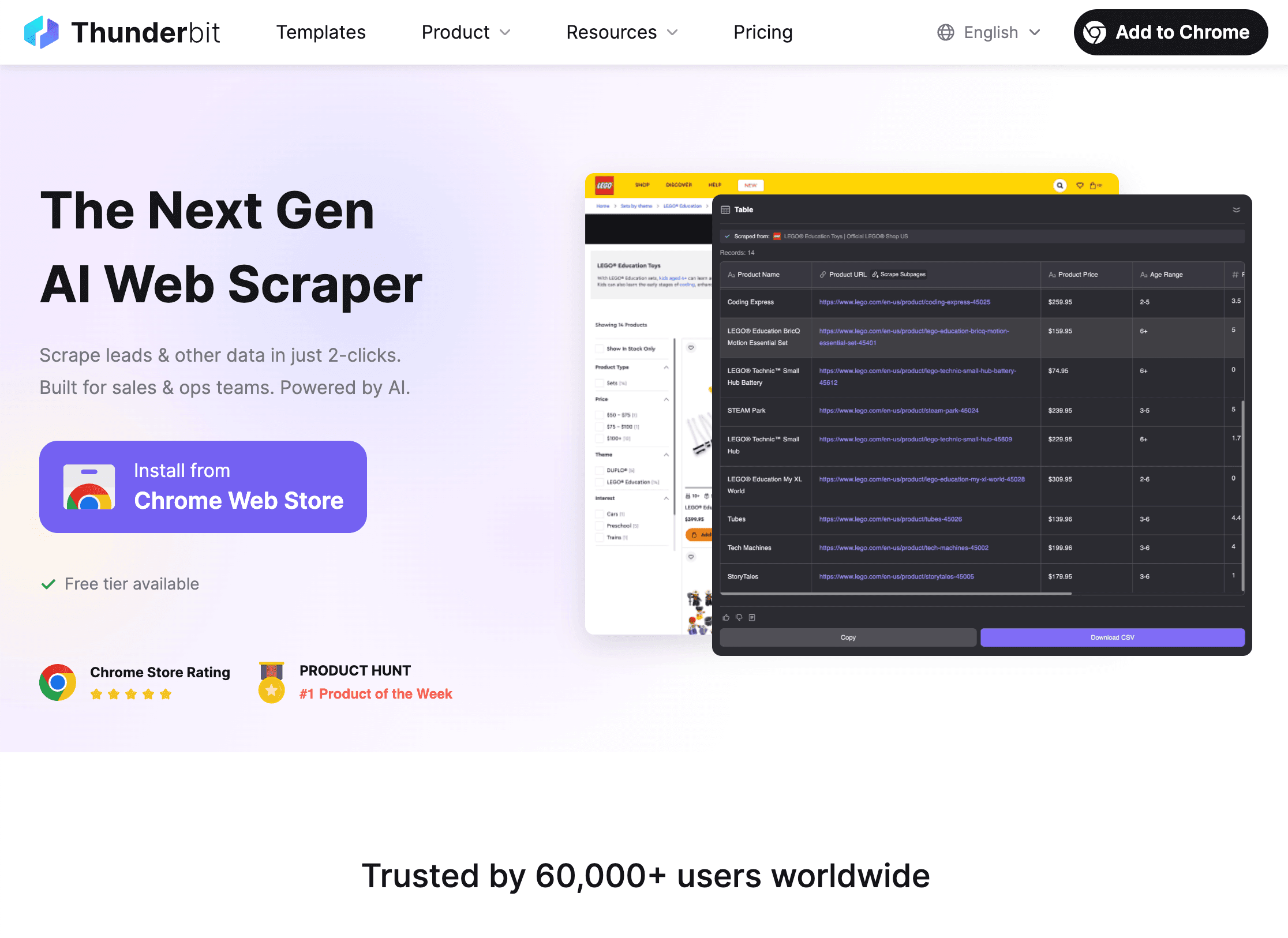
is my go-to recommendation for non-technical teams who want to collect web data fast—without any coding, templates, or headaches. As the co-founder and CEO, I might be a little biased, but I built Thunderbit because I was tired of seeing business users struggle with clunky, developer-focused tools.
What sets Thunderbit apart? It’s all about simplicity and power:
- AI-Powered Field Suggestion: Just click “AI Suggest Fields,” and Thunderbit’s AI reads the page, recommends the best columns (like names, prices, emails), and even sets up data types for you.
- Two-Click Scraping: Navigate to any website, click “Scrape,” and Thunderbit does the rest—no setup, no selectors, no fuss.
- Subpage & Pagination Scraping: Need to grab details from subpages (like product details or LinkedIn profiles)? Thunderbit can visit each subpage and enrich your table automatically. It also handles pagination, including infinite scroll.
- Instant Templates: For popular sites like Amazon, Zillow, and Instagram, Thunderbit offers one-click templates—just enter your query and export the data.
- Free Data Export: Export your results to Excel, Google Sheets, Airtable, or Notion—completely free.
- Advanced Features: Scrape data from PDFs, images, and even automate form-filling with AI Autofill (also free). Schedule scrapes to run automatically with natural language instructions.
- Pricing: Thunderbit uses a credit system—scrape up to 6 pages for free (or 10 with a trial boost). Paid plans start at just $15/month (or $9/month billed annually) for 500 rows, making it accessible for teams of any size.
Thunderbit is trusted by over , from sales and marketing teams to real estate agents and ecommerce operators. The feedback I hear most often? “I can’t believe how much time this saves—I used to spend hours copying leads from directories, now it’s done in minutes.” If you want to see for yourself, and give it a spin.
2. Octoparse
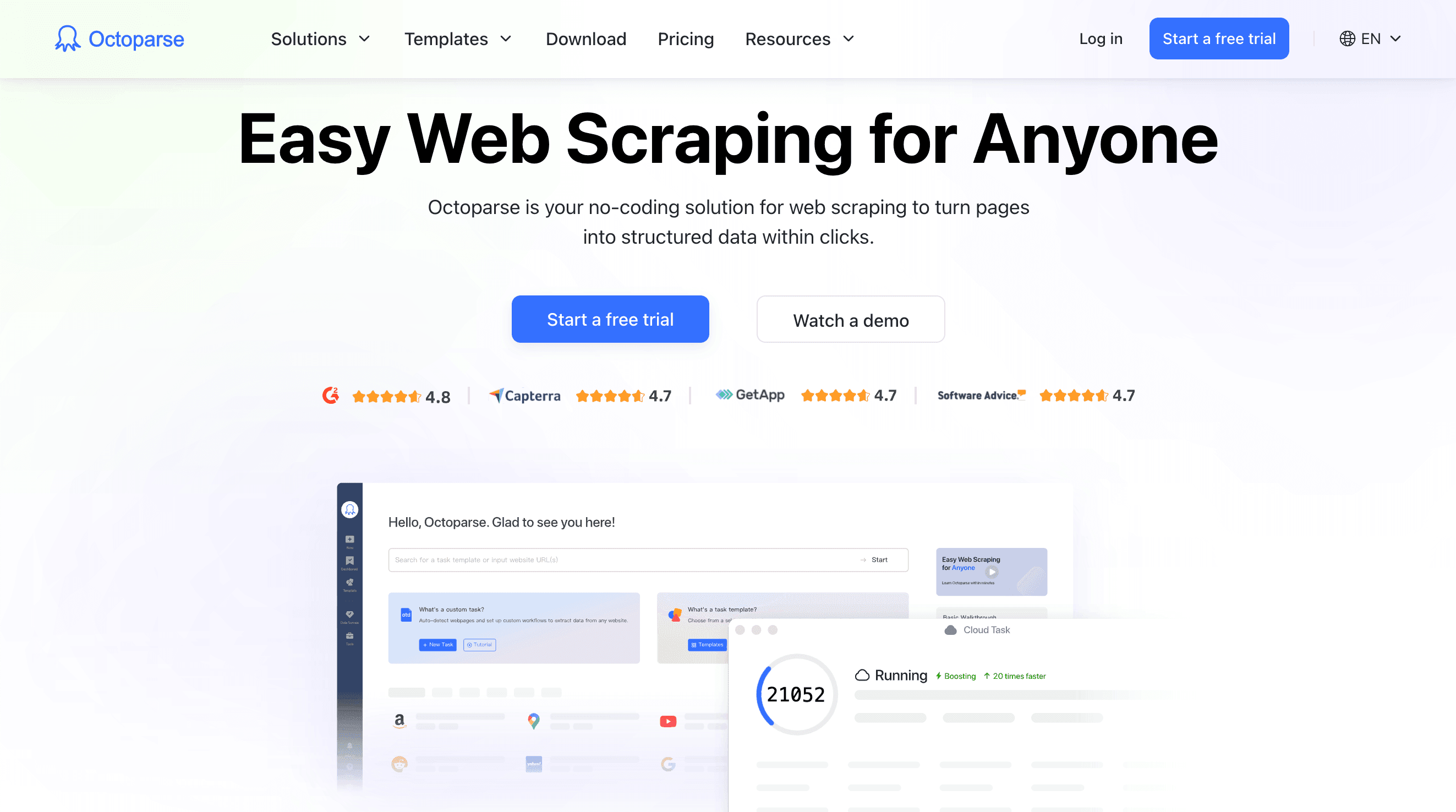
is a heavyweight in the no-code scraping world, offering a visual, drag-and-drop interface for building custom scraping workflows. If you’re a power user who wants to handle complex websites—think logins, AJAX, infinite scroll, and multi-step navigation—Octoparse gives you the tools to do it, all without writing a line of code.
Key features:
- Visual Workflow Designer: Click through a sample page, and Octoparse detects similar elements, helping you build a data extraction workflow step by step.
- Handles Dynamic Content: Supports JavaScript-heavy sites, infinite scroll, and login-protected pages.
- Cloud Scraping: Run jobs in the cloud (so your computer doesn’t have to stay on), schedule scrapes, and process large volumes of data 24/7.
- Templates Library: Access 100+ pre-built templates for popular sites like Amazon, LinkedIn, and Twitter.
- Export Options: Download results as CSV, Excel, or JSON, or push data directly to your database.
- Pricing: Free tier with limited capabilities; paid plans start at ~$75/month for the Standard plan, with higher tiers for more concurrency and advanced features.
Octoparse is ideal for analysts, researchers, and small businesses who need robust, no-code scraping at medium scale. There’s a learning curve, especially for advanced workflows, but the visual interface and strong documentation make it accessible for tech-savvy users who don’t want to code.
3. ParseHub
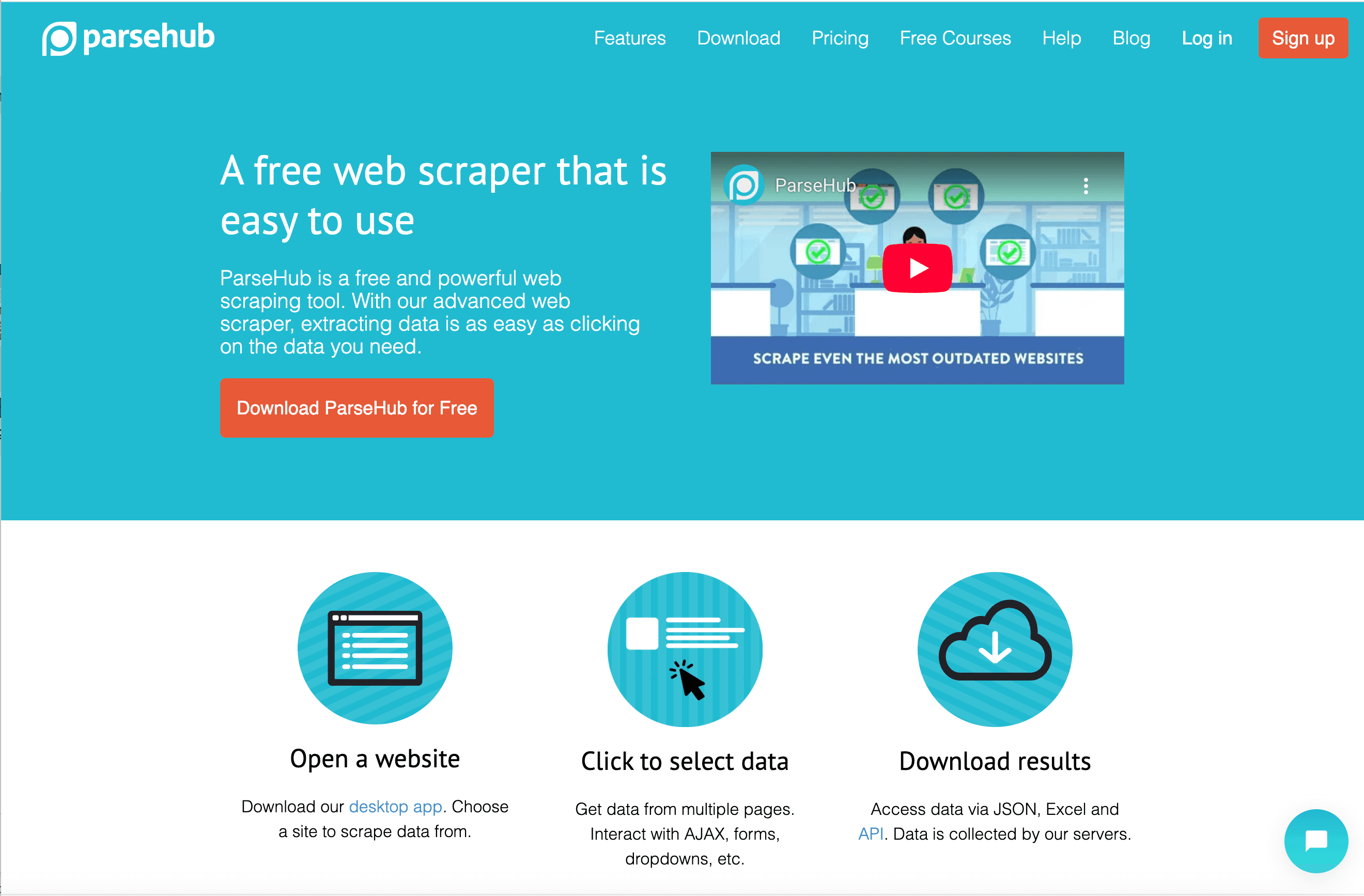
is another visual scraping tool, best known for its ability to handle complex, dynamic websites using a desktop app. If you need to scrape data from sites with heavy JavaScript or tricky interactive elements, ParseHub’s simulated browser approach is a strong fit.
What makes ParseHub stand out:
- Desktop Visual Scraper: Build projects by clicking through the site in the app’s built-in browser. ParseHub detects patterns and lets you select exactly what you need.
- Handles JavaScript & AJAX: Waits for content to load, clicks buttons, fills forms, and navigates interactive sites.
- API Integration: Trigger projects and fetch results programmatically.
- Cloud Scheduling: Schedule jobs to run in the cloud (on higher-tier plans).
- Export Options: Download data as CSV, Excel, or JSON.
- Pricing: Free plan lets you scrape up to 200 pages per run; paid plans start at $189/month for Standard and $599/month for Professional.
ParseHub is a favorite among data journalists, researchers, and small businesses who need to scrape dynamic sites and prefer a desktop environment. The guided onboarding is helpful for beginners, but the pricing can be steep for heavy users.
4. Scrapy
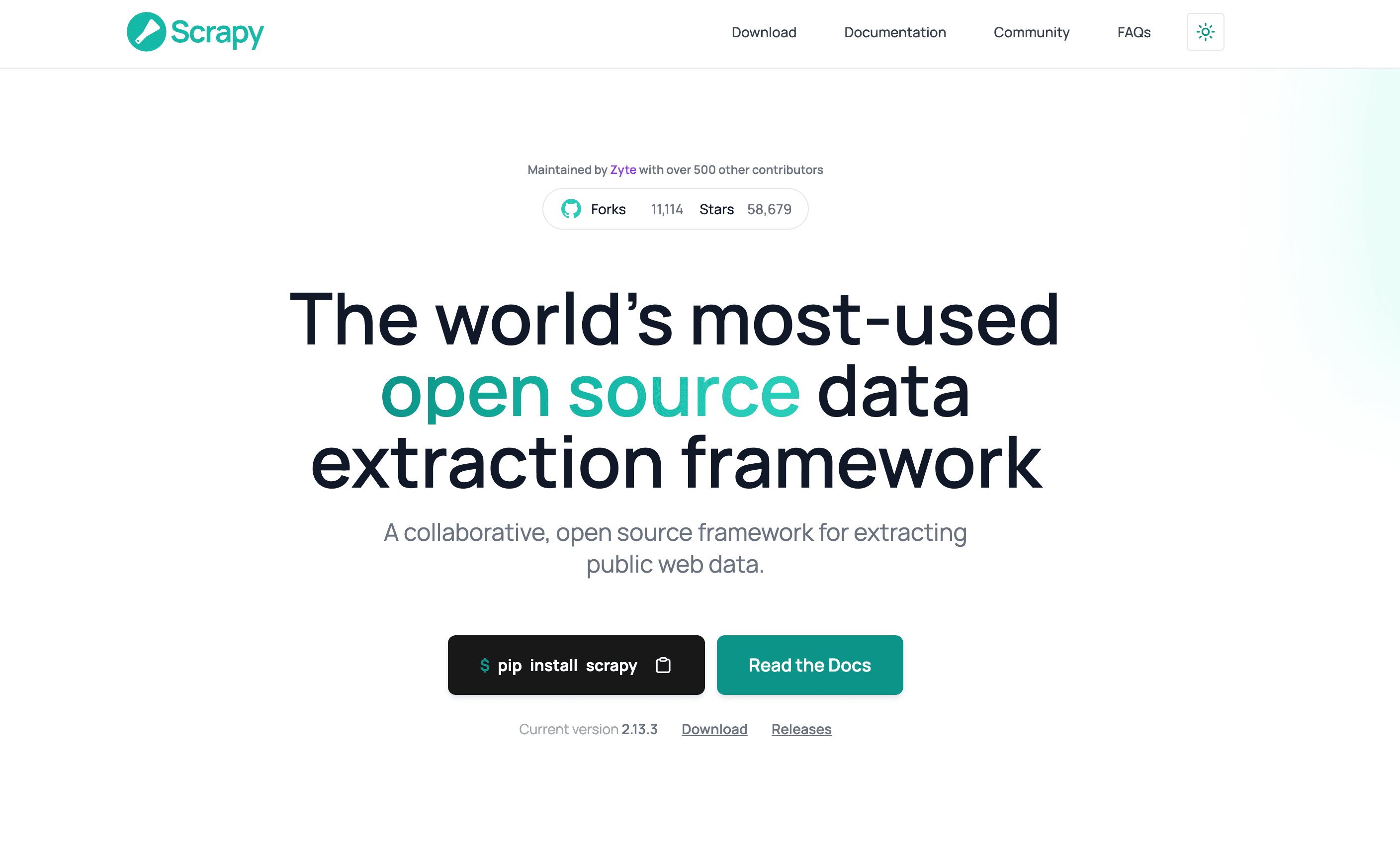
is the tool of choice for developers and technical teams who want full control over their scraping projects. It’s a Python-based, open-source framework that lets you build custom web crawlers—perfect for large-scale, complex, or highly customized scraping jobs.
Why Scrapy is a developer favorite:
- Ultimate Flexibility: Write Python code to define spiders, crawling rules, and data pipelines. Scrapy handles concurrency, retries, and data export.
- Performance: Designed for speed and scalability—scrape thousands or millions of pages efficiently.
- Extensibility: Integrate with proxies, databases, APIs, and custom middleware.
- Open Source: Free to use; costs come from your own infrastructure or cloud hosting (like Zyte’s Scrapy Cloud).
- Community: Huge ecosystem, mature documentation, and plenty of tutorials.
Scrapy isn’t for the faint of heart—there’s a steep learning curve, and you’ll need to maintain your own code. But if you have developers on your team and need to build a robust, scalable data pipeline, Scrapy is hard to beat.
5. Diffbot
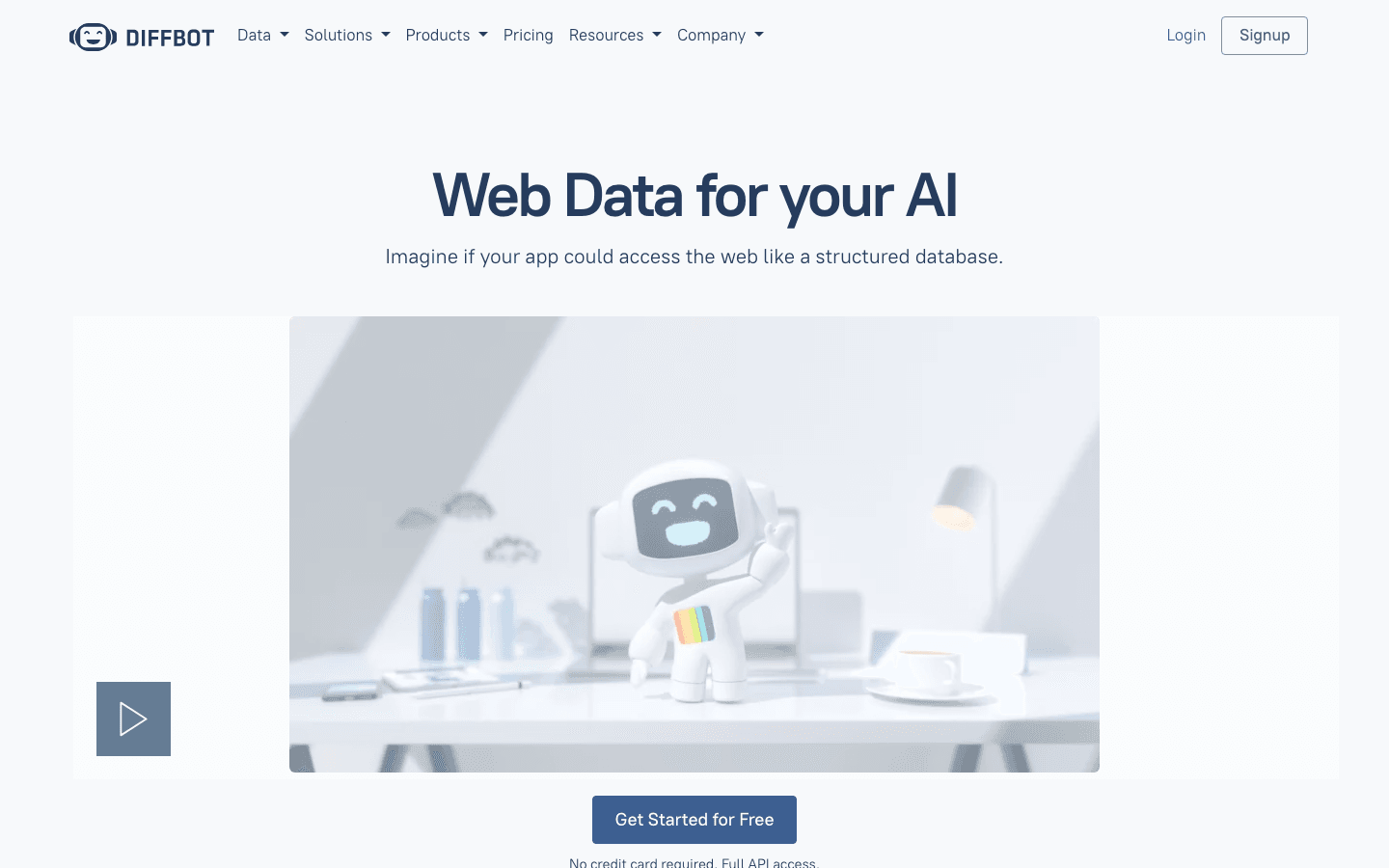
takes a radically different approach: it uses AI and machine learning to automatically analyze and extract structured data from any web page. Instead of building scrapers, you send Diffbot a URL (via API), and it returns clean, structured JSON—no selectors or setup required.
What makes Diffbot unique:
- AI-Driven Extraction: Pre-trained APIs for articles, products, discussions, and more. Diffbot “reads” the page like a human and extracts key fields.
- Crawlbot: Crawl entire sites or sitemaps automatically.
- Knowledge Graph: Tap into Diffbot’s massive database of over 1.2 billion websites, 246 million organizations, and more.
- Scalability: Built for enterprise-scale data collection.
- Pricing: Free tier (10,000 credits/month); paid plans start at $299/month for 250,000 credits, with higher tiers for more volume.
Diffbot is best for enterprises, data scientists, and anyone who needs huge amounts of structured web data without building or maintaining scrapers. It’s not as customizable as code-based tools, but for hands-off, AI-powered extraction at scale, Diffbot is unmatched.
6. DataMiner
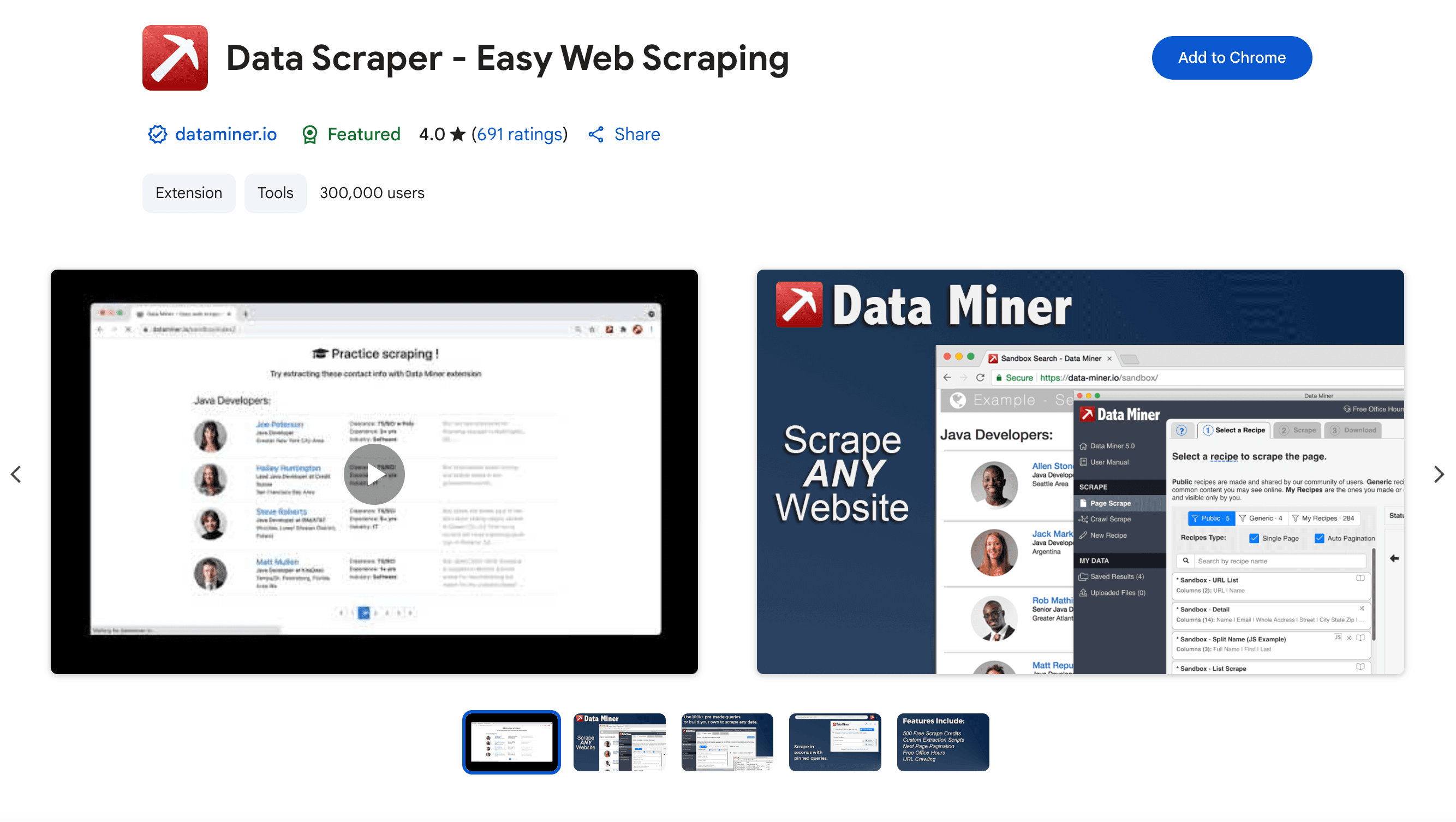
is a browser extension (for Chrome and Edge) that makes quick, one-off data extraction a breeze. If you’re a growth hacker, journalist, or business user who just wants to grab a table or list from a web page into Excel, DataMiner is your new best friend.
Why users love DataMiner:
- Point-and-Click Simplicity: Click elements on the page to build a “recipe,” or use one of 60,000+ public recipes for 15,000+ websites.
- One-Click Extraction: Apply a recipe and export data instantly to CSV or Excel.
- Pagination & Bulk Scraping: Handle multi-page lists and even supply a list of URLs for batch processing.
- Form Filling: Automate form submissions using data from a CSV.
- Free Tier: Scrape up to 500 pages per month for free; paid plans start at $19.99/month for 2,500 pages.
DataMiner is perfect for ad-hoc tasks, quick research, and anyone who prefers working directly in their browser. It’s not built for massive jobs, but for small-to-medium projects, it’s incredibly handy.
Quick Comparison Table: Screen Scraping Tools at a Glance
| Tool | Ease of Use | Key Features | Best For | Pricing Model | Unique Strength |
|---|---|---|---|---|---|
| Thunderbit | Very easy (no-code) | AI field suggestion, subpage/pagination, templates, free export | Non-technical business users (sales, ops, real estate) | Free/From $9–$15/mo | Easiest setup, AI-powered, rapid ad-hoc scraping |
| Octoparse | Moderate (no-code) | Visual workflow, cloud runs, dynamic sites, templates | Tech-savvy analysts, researchers | Free/From $75/mo | Visual builder, cloud scheduling, advanced logic |
| ParseHub | Moderate (no-code) | Desktop app, JS/AJAX handling, API, cloud runs | Dynamic sites, technical beginners | Free/From $189/mo | Handles tricky sites, desktop control |
| Scrapy | Hard (Python code) | Open-source, scalable, full control, pipelines | Developers, engineering teams | Free (self-hosted) | Ultimate flexibility, large-scale custom scraping |
| Diffbot | Easy (for devs) | AI extraction, APIs, Knowledge Graph, crawlbot | Enterprises, data scientists | Free/From $299/mo | Hands-off AI, web-wide data, massive scale |
| DataMiner | Very easy (browser) | Browser extension, 60k+ recipes, one-click, forms | Ad-hoc tasks, journalists, growth hackers | Free/From $19.99/mo | Fastest browser-based, huge template library |
Which Screen Scraping Tool Is Right for You?
- Need no-code, instant results? Go with Thunderbit or DataMiner. Thunderbit is best for structured, multi-page, or subpage scraping with AI help; DataMiner is perfect for quick, browser-based tasks.
- Want visual workflows and cloud power? Octoparse is your friend, especially if you’re handling complex sites or need to schedule recurring scrapes.
- Scraping dynamic, JavaScript-heavy sites? ParseHub’s desktop approach shines here, especially for technical beginners.
- Have developers and need full control? Scrapy is the gold standard for custom, large-scale scraping.
- Need AI-driven, enterprise-scale data? Diffbot delivers hands-off, structured data extraction and a massive knowledge graph.
My advice? Start with a free trial or tier—most of these tools let you test-drive before you commit. Match your technical comfort, data volume, and workflow needs to the right tool, and don’t be afraid to experiment.
Conclusion: Unlocking Data Collection with the Right Screen Scraping Tool
Screen scraping tools have gone from niche developer toys to essential business productivity boosters. Whether you’re a sales rep hunting for leads, an ecommerce manager tracking prices, or a real estate agent gathering listings, the right tool can turn the web into your own personal database. The key is to pick a tool that matches your team’s skills and your business goals—because the best screen scraping tool is the one you’ll actually use.
Ready to stop copy-pasting and start collecting data like a pro? or try out one of the other tools on this list. And if you want more tips, deep dives, and tutorials, check out the .

FAQs
1. What is a screen scraping tool and how does it work?
A screen scraping tool automates the process of extracting data from websites. Instead of manually copying information, these tools let you select what you want and export it in a structured format like Excel or CSV. Some use AI or visual workflows to make setup easy for non-technical users.
2. Who should use screen scraping tools?
Anyone who needs to collect web data efficiently—sales teams, marketers, real estate agents, researchers, and operations analysts. Whether you’re building lead lists, tracking competitors, or aggregating listings, these tools save time and reduce errors.
3. What’s the difference between no-code and code-based scraping tools?
No-code tools (like Thunderbit, Octoparse, ParseHub, DataMiner) offer point-and-click interfaces and are designed for non-technical users. Code-based tools (like Scrapy) require programming skills but offer more flexibility and scalability for complex projects.
4. Are screen scraping tools legal to use?
Screen scraping is legal for publicly available data, but you should always respect website terms of service and privacy laws. Avoid scraping personal data without consent and don’t overload websites with excessive requests.
5. How do I choose the best screen scraping tool for my needs?
Consider your technical skills, data volume, the complexity of your target sites, export needs, and budget. Start with a free trial, test your use case, and see which tool feels most intuitive and delivers the results you want.
Ready to unlock the power of web data? Give one of these tools a try and watch your productivity soar.